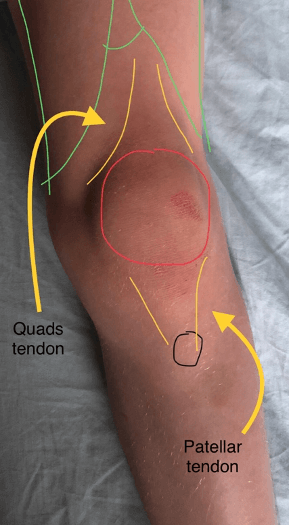Painful lumps below the knee in adults can be a cause for concern, as they may indicate underlying medical conditions that require attention. These mysterious bumps, which can range in size and discomfort, often leave individuals searching for answers and relief. While not all lumps are a cause for alarm, some may be indicative of more serious issues that demand medical evaluation and treatment.
The human knee is a complex joint that undergoes significant stress and strain throughout a person’s life. As such, it is susceptible to a wide range of issues, including injuries, infections, and various medical conditions. When a painful lump appears below the knee, it can be a source of anxiety and discomfort, prompting individuals to seek answers about its origin, potential complications, and available treatment options.
Check out our Knee Pads for Comfort and Relief
In this comprehensive article, we will delve into the potential causes of painful lumps below the knee in adults, exploring both common and less frequently encountered conditions. We will discuss the key symptoms to watch for, when to consult a healthcare professional, and the diagnostic and treatment options available. Whether you’ve recently noticed a lump on your knee or you’re looking to expand your knowledge on this subject, this article will provide valuable insights to help you better understand and address this issue. Remember that, while this information can be informative, it should not substitute professional medical advice, and it is always best to consult a healthcare provider for a proper diagnosis and treatment plan tailored to your specific situation.
Common Causes of Painful Lumps Below the Knee:
- Bursitis: Bursae are small, fluid-filled sacs that cushion the joints. When these sacs become inflamed, it can lead to a painful lump below the knee. Bursitis is often caused by repetitive movements, trauma, or infection and typically presents as localized swelling and discomfort.
- Cyst Formation: Ganglion cysts are non-cancerous, fluid-filled sacs that can develop near joints, including the knee. These cysts can cause a noticeable lump below the knee, along with pain or discomfort. They often arise due to joint irritation or injury.
- Lipoma: A lipoma is a benign, fatty tumor that can grow underneath the skin. Although typically harmless, it can lead to the formation of a palpable lump and, in some cases, pain.
Less Common Causes to Consider:
- Tumors: In rare cases, painful lumps below the knee can be the result of malignant or benign tumors. Cancerous growths, such as sarcomas, can occur in the soft tissues around the knee joint. Timely evaluation is crucial if a tumor is suspected, as early detection is key to successful treatment.
- Gout: Gout is a type of arthritis that can lead to the buildup of uric acid crystals in the joints, including the knee. These crystals can cause intense pain and inflammation, resulting in a swollen lump.
- Infections: Infections, such as abscesses or cellulitis, can lead to the development of a painful lump below the knee. In these cases, the lump may be accompanied by redness, warmth, and fever.
When to Seek Medical Attention:
If you or someone you know experiences a painful lump below the knee, it’s essential to pay close attention to the following signs and symptoms that warrant prompt medical evaluation:
- Persistent Pain: If the pain is severe, constant, or worsening over time, it should not be ignored. Chronic discomfort can be an indication of an underlying problem.
- Change in Size or Appearance: If the lump changes in size, shape, or color, it could signal an issue that requires medical attention.
- Difficulty Moving the Knee: If the lump impairs your ability to move the knee joint or walk, this should be evaluated immediately.
- Fever and Redness: If the lump is accompanied by a fever, warmth, redness, or signs of infection, it’s crucial to consult a healthcare provider promptly.
Diagnosis and Treatment Options:
A healthcare professional will typically perform a physical examination and, if necessary, order imaging studies such as X-rays, ultrasounds, or MRI scans to determine the underlying cause of the lump. Once a diagnosis is made, the treatment approach will depend on the specific condition but may include:
- Medications: Anti-inflammatory drugs, antibiotics, or pain relievers may be prescribed to manage symptoms.
- Aspiration: In some cases, a healthcare provider may drain a cyst or an abscess to alleviate discomfort.
- Physical Therapy: Rehabilitation exercises may be recommended to improve joint mobility and strength.
- Surgery: In more severe cases, surgical intervention may be required to remove a tumor, cyst, or address underlying issues.
Conclusion:
In the realm of medical concerns, a painful lump below the knee in adults can undoubtedly be a cause for anxiety. As we’ve explored in this article, the causes of such lumps can vary widely, from relatively benign issues like bursitis and cysts to more serious conditions such as tumors or infections. The key takeaway is that understanding the potential reasons behind these lumps is the first step toward appropriate evaluation and treatment.
It’s crucial to remember that while knowledge is empowering, it should not replace professional medical advice. If you or someone you know is experiencing a painful lump below the knee, consulting a healthcare provider is imperative. The expertise of a medical professional is invaluable in accurately diagnosing the underlying issue and tailoring a treatment plan to suit the individual’s specific needs.
Prompt attention to these lumps is not just about finding relief from pain and discomfort but can also significantly impact the long-term prognosis. In the case of more severe conditions like tumors or infections, early diagnosis and intervention can be life-saving.
This article has provided an overview of common and less common causes of painful lumps below the knee, highlighted key symptoms that should prompt a medical evaluation, and discussed potential diagnostic and treatment options. Armed with this knowledge, individuals are better equipped to make informed decisions about their health and to engage in open and proactive communication with their healthcare providers.
In closing, if you are facing the uncertainty and discomfort of a painful lump below your knee or if you know someone who is, remember that the path to relief and recovery begins with a visit to a healthcare professional. The human body is intricate and complex, and addressing health concerns requires the expertise and guidance of those dedicated to medical care. Your well-being is paramount, and seeking professional help is a vital step in the journey toward healing and improved quality of life.





